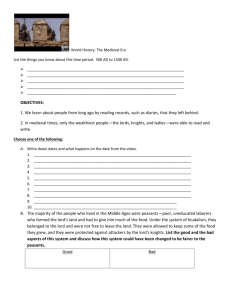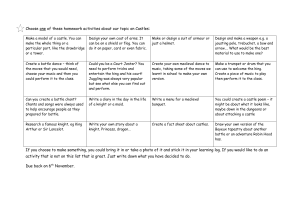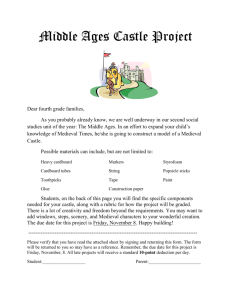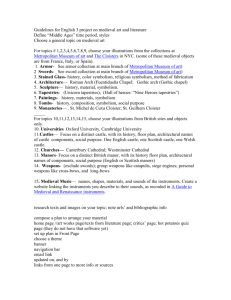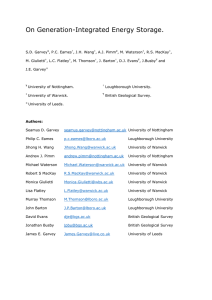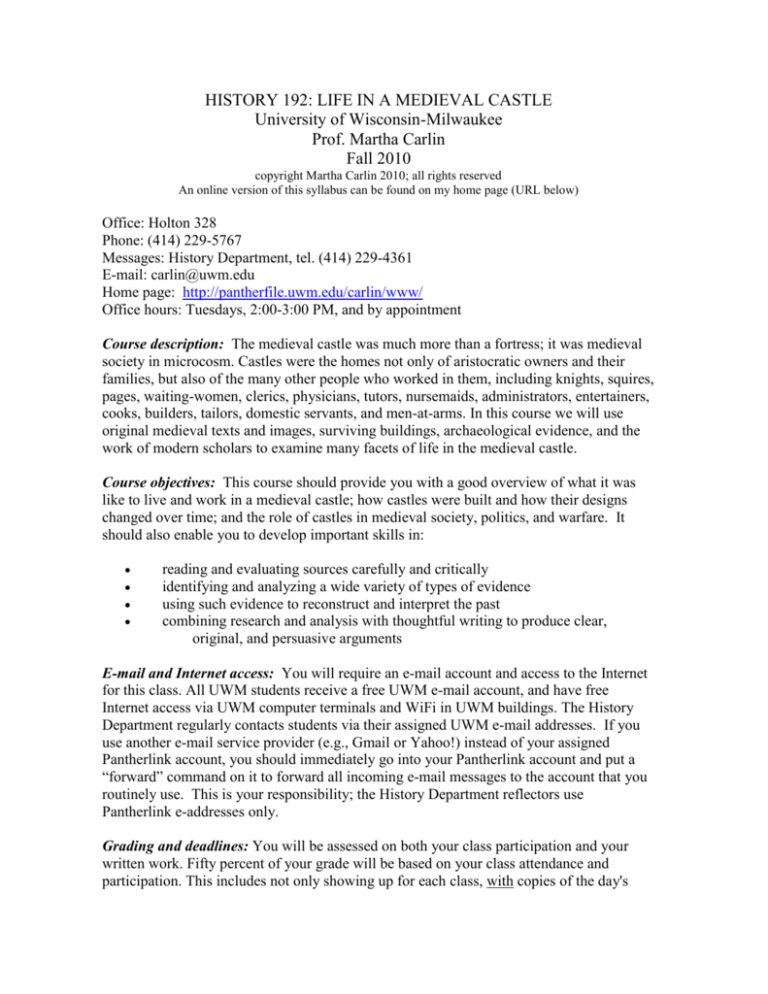
HISTORY 192: LIFE IN A MEDIEVAL CASTLE
University of Wisconsin-Milwaukee
Prof. Martha Carlin
Fall 2010
copyright Martha Carlin 2010; all rights reserved
An online version of this syllabus can be found on my home page (URL below)
Office: Holton 328
Phone: (414) 229-5767
Messages: History Department, tel. (414) 229-4361
E-mail: carlin@uwm.edu
Home page: http://pantherfile.uwm.edu/carlin/www/
Office hours: Tuesdays, 2:00-3:00 PM, and by appointment
Course description: The medieval castle was much more than a fortress; it was medieval
society in microcosm. Castles were the homes not only of aristocratic owners and their
families, but also of the many other people who worked in them, including knights, squires,
pages, waiting-women, clerics, physicians, tutors, nursemaids, administrators, entertainers,
cooks, builders, tailors, domestic servants, and men-at-arms. In this course we will use
original medieval texts and images, surviving buildings, archaeological evidence, and the
work of modern scholars to examine many facets of life in the medieval castle.
Course objectives: This course should provide you with a good overview of what it was
like to live and work in a medieval castle; how castles were built and how their designs
changed over time; and the role of castles in medieval society, politics, and warfare. It
should also enable you to develop important skills in:
reading and evaluating sources carefully and critically
identifying and analyzing a wide variety of types of evidence
using such evidence to reconstruct and interpret the past
combining research and analysis with thoughtful writing to produce clear,
original, and persuasive arguments
E-mail and Internet access: You will require an e-mail account and access to the Internet
for this class. All UWM students receive a free UWM e-mail account, and have free
Internet access via UWM computer terminals and WiFi in UWM buildings. The History
Department regularly contacts students via their assigned UWM e-mail addresses. If you
use another e-mail service provider (e.g., Gmail or Yahoo!) instead of your assigned
Pantherlink account, you should immediately go into your Pantherlink account and put a
“forward” command on it to forward all incoming e-mail messages to the account that you
routinely use. This is your responsibility; the History Department reflectors use
Pantherlink e-addresses only.
Grading and deadlines: You will be assessed on both your class participation and your
written work. Fifty percent of your grade will be based on your class attendance and
participation. This includes not only showing up for each class, with copies of the day's
2
assigned readings, but also doing the assigned reading on time, before coming to class, and
taking an active part in discussions and other in-class work. The other fifty percent of your
grade will be based on your out-of-class assignments (described at end of syllabus).
Assignments are due on the dates specified. Late work will not be accepted, except in
cases of major illness or emergency (it is your responsibility to contact me immediately in
such a case).
Exams: There will be no midterm or final exam for this course, but there may be
unannounced quizzes, which will count towards your final grade.
Attendance: There will be two class meetings each week, and your attendance at each
class is required. Your grade will be lowered if you miss class, except in genuine cases of
illness or emergency (it is your responsibility to contact me immediately in such a case).
Students who do not attend class during the first week of classes may be dropped
administratively.
Disabilities: If you have a disability, it is important that you contact me early in the
semester for any help or accommodation you may need.
Academic Advising in History: All L&S students have to declare and complete an
academic major to graduate. If you are interested in declaring a major or minor in History,
or require academic advising in History, please visit the Department of History’s
undergraduate program web page at
http://www4.uwm.edu/letsci/history/undergrad/
There are two required textbooks:
Gies, Joseph, and Frances Gies. Life in a Medieval Castle. New York: Thomas Y.
Crowell, 1974; rpt Harper & Row, 1979. (Listed below in Topics and Readings as "Gies
and Gies, Life.")
Macaulay, David. Castle. Boston: Houghton Mifflin, 1977.
There will also be required reading assignments (see Topics and Readings) from online
resources and also from the books and articles listed below, which are available in the
Course Reserve department in the East Wing of the library. All of the Course Reserve
readings are available online via e-reserve, and in hard copy on two-hour reserve. You will
find the online versions of these reserve readings at the following website:
http://www4.uwm.edu/libraries/ereserve/mcarlin/HIST192.html
3
COURSE RESERVE READINGS FOR HISTORY 192
(These books can also be found on two-hour reserve in the Course Reserve department in
the East Wing of the UWM Library. Their call numbers given below.)
Bennett, Matthew. "The Medieval Warhorse Reconsidered." In Medieval Knighthood, V.
Papers from the Sixth Strawberry Hill Conference, 1994. Ed. Stephen Church and Ruth
Harvey. Woodbridge, Suffolk: Boydell Press, 1995, pp. 19-40.
Call no.: CR4513 I34 1994
----------. "The Status of the Squire: The Northern Evidence." In The Ideals and Practice of
Medieval Knighthood. Papers from the First and Second Strawberry Hill Conferences. Ed.
Christopher Harper-Bill and Ruth Harvey. Woodbridge, Suffolk: Boydell Press, 1986, pp.
1-11.
Call no.: CR4513 I34 1986
Brown, R. Allen. Allen Brown’s English Castles. Woodbridge, Suffolk: Boydell, 2004
(reprint of 1976 edn, with new Introduction by Jonathan Coad), pp. 140-149 (the castle in
war).
Call no.: DA660 .B85 2004
Gies, Frances, and Joseph Gies. Marriage and Family in the Middle Ages. New York:
Harper and Row, Perennial Library, 1987.
Call no.: HQ513 G53 1987
----------. Women in the Middle Ages. New York: Harper and Row, Perennial Library, 1978.
Call no.: Q1143 G53 1978
Holmes, Urban Tigner, Jr. Daily Living in the Twelfth Century. Madison: University of
Wisconsin Press, 1952.
Call no.: CB353 H65
Labarge, Margaret Wade. A Baronial Household of the Thirteenth Century. New York:
Barnes and Noble, 1965, rpt 1980, Chaps. 1 (pp. 18-37), 3 (pp. 53-70), 7 (pp. 116-128), and
pp. 166-172, plus notes on pp. 203-4, 206-7, 212-13, 216-17.
Call nos.: DA185 L3 and DA185 L3 1980
[The above book was subsequently reprinted under the title Mistress, Maids and Men:
Baronial Life in the Thirteenth Century, London: Phoenix Books: 2004 (ISBN: 1-84212499-4; ISBN 13: 978-1-84212-499-4). This reprint edition is now out of print, but if you
are interested you might find copies in other libraries or for sale second-hand.]
Labarge,Margaret Wade. A Small Sound of the Trumpet. Boston: Beacon, 1986, Chap. 4
(“Women Who Ruled: Noble Ladies”), pp. 72-97, plus notes on pp. 243-4.
Call no.: HQ 1147 .E853 L33 1986
4
Paterson, Linda M. "Military Surgery: Knights, Sergeants, and Raimon of Avignon's
Version of the Chirurgia of Roger of Salerno (1180-1209)." In The Ideals and Practice of
Medieval Knighthood, II. Papers from the Third Strawberry Hill Conference, 1986. Ed.
Christopher Harper-Bill and Ruth Harvey. Woodbridge, Suffolk: Boydell Press, 1988, pp.
117-146.
Call no.: CR4513 .I34 1988
Peirce, Ian. "The Knight, His Arms and Armour in the Eleventh and Twelfth Centuries." In
The Ideals and Practice of Medieval Knighthood. Papers from the First and Second
Strawberry Hill Conferences. Ed. Christopher Harper-Bill and Ruth Harvey. Woodbridge,
Suffolk: Boydell Press, 1986, pp. 152-164.
Call no.: CR4513 I34 1986
Pisan, Christine de. The Treasure of the City of Ladies. Trans. Sarah Lawson.
Harmondsworth, Middlesex, and New York: Penguin, 1985, pp. 128-133.
Call no.: PQ1575 L56 E52x 1985
Pounds, N. J. G. The Medieval Castle in England and Wales: A Social and Political
History. Cambridge: Cambridge University Press, 1990.
Call no.: DA660 P68 1990
Prestwich, Michael. Armies and Warfare in the Middle Ages: The English Experience. New
Haven and London: Yale University Press, 1996.
Call no.: DA60 .P74 1996
Prestwich, Michael. “The Garrisoning of English Medieval Castles.” In The Normans and
Their Adversaries at War: Essays in Memory of C. Warren Hollister. Ed. Richard P. Abels
and Bernard Bachrach. Woodbridge, Suffolk: Boydell & Brewer, 2001, pp. 185-200.
Call no.: U37 .N67 2001
Shahar, Shulamith. Childhood in the Middle Ages. Trans. Chaya Galai. London and New
York: Routledge, 1990, pp. 209-224, 320-325.
Call no.: HQ792 E8 S53 1990
Singman, Jeffrey L. Daily Life in Medieval Europe. Westport, Conn., and London :
Greenwood Press, 1999, pp. 17-27 (plus notes on p. 32), 46-50, 57-64, 119-138
Call no.: D119 .S55 1999
There is a useful online Timeline of British History, 1066-1485, which includes brief
biographies of English kings, at:
http://www.britannia.com/history/time2.html
5
TOPICS AND READINGS FOR CLASS
Week 1
INTRODUCTION
2 September Introduction to course
Week 2
THE NORMANS COME TO ENGLAND; EARLY CASTLES AND THEIR
LORDS
7 September
Assignment 1 due (required of all students)
Gies and Gies, Life, pp. 1-20
The Anglo-Saxon Chronicle: William I
http://www.fordham.edu/halsall/source/1186ASChron-William1.html
9 September
Week 3
Gies and Gies, Life, Chap. 2 (pp. 32-56)
Henry of Huntingdon: Baronial behavior in Stephen's reign,
1135-54
http://www.fordham.edu/halsall/source/henry-hunt1.html
BUILDING THE CASTLE
14 September
Assignment 2 due
Gies and Gies, Life, pp. 21-31
Macaulay, pp. 5-37
Pounds, pp. 102-6, 126-9
16 September
Macaulay, pp. 38-63
Master James of St. George: biographical sketch, and letter
concerning building progress at Beaumaris Castle (see both
websites below)
http://www.castlewales.com/jsgeorge.html
http://www.castlewales.com/beau3.html
Week 4 THE CASTLE AS A HOUSE
21 September Assignment 3 due
Gies and Gies, Life, Chap. 3 (pp. 57-74)
Holmes, pp. 18, 82 (mid-page) -87, 178 (last paragraph) -191
23 September Labarge, Chap. 1 (“The Castle as a Home”), pp. 18-37
Singman, Daily Life in Medieval Europe, pp. 46-50, 126 (midpage) - 138
Description of a manor house, 1265
http://www.fordham.edu/halsall/source/chingford.html
A poor knight's household, from Chrétien de Troyes, Erec and
Enide, vv. 342-546
6
http://sunsite.berkeley.edu/OMACL/Erec/
Week 5
THE LADY OF THE CASTLE
28 September Assignment 4 due
Gies and Gies, Life, Chap. 4 (pp. 75-94)
Labarge, A Small Sound of the Trumpet, Chap. 4 (“Women Who
Ruled: Noble Ladies”), pp. 72-97.
Bartholomaeus Anglicus, On the Properties of Things (man and
wife)
http://pantherfile.uwm.edu/carlin/www /Trevisa's Bartholomew.Man
and Wife.htm
30 September Gies and Gies, Women in the Middle Ages, Chap. 7 (pp. 120-142):
"A Great Lady: Eleanor de Montfort" [Note that this is a different
book by the Gieses than your course textbook!]
Pisan, Part II, Chaps. 9-10, pp. 128-133: "Of baronesses," and "How
ladies and young women who live on their manors ought to manage
their households and estates"
Week 6
THE CASTLE HOUSEHOLD AND ECONOMY
5 October Assignment 5 due
Gies and Gies, Life, Chap. 5 (pp. 95-108)
Labarge, Chap. 3 (pp. 53-70)
7 October
Prestwich, “The Garrisoning of English Medieval Castles.”
Singman, pp. 46-53, 57-64
Household Expenses of Thomas, Earl of Lancaster, 1313-1
http://pantherfile.uwm.edu/carlin/www/LancasterExpenses.htm
Week 7 LIFE IN THE CASTLE
12 October Assignment 6 due
Gies and Gies, Life, Chap. 6 (pp. 109-124) and Chap. 11
(pp. 206-216)
John Russell, Boke of Nurture (c. 1460): How to serve one's master
at table
http://jrider.web.wesleyan.edu/wescourses/2001f/fren234/01/bookofnurture.htm
14 October
Labarge, Chap. 7 (“Cooking and Serving of Meals”), pp. 116-128
Holmes, pp. 87 (bottom) - 94
Week 8 CHILDHOOD AND ADOLESCENCE IN THE CASTLE
7
19 October Assignment 7 due
Gies and Gies, Marriage and the Family, Chap. 10 (pp. 196-217):
“Children in the Middle Ages” [Note that this is a different
book by the Gieses than your course textbook!]
Singman, Daily Life in Medieval Europe, pp. 17-27 (notes on p. 32)
21 October Shahar, Chap. 10 (first part), pp. 209-213 (with notes on pp. 320322): "Education in the nobility"
Sophie Oosterwijk, "The Medieval Child: An Unknown
Phenomenon?"
http://www.the-orb.net/non_spec/missteps/ch6.html
Gies and Gies, Marriage and the Family, pp. 141-145
An aristocratic education, from John Harding's Chronicle (c. 1457);
and the ideal squire, from Philippe de Remi, sire de
Beaumanoir's Blonde of Oxford (Jehan et Blonde, c. 125065)
http:// pantherfile.uwm.edu/carlin/www /Harding &
Beaumanoir.Squires.htm
Week 9 EDUCATION AND MANNERS
26 October
Assignment 8 due
Shahar, Chap. 10 (second part), pp. 214-224 (with notes on pp.
322-325): "Education in the nobility"
“Schooling” (9 extracts from the writings of Guibert of
Nogent and others)
http://www.fordham.edu/halsall/source/medieval-memory.html#Schooling
"Distichs of Cato" (a medieval schoolbook for teaching Latin);
read editor's introduction, and then click on "The
Monostichs, as `Prologue'" and read that page also
http://www.courses.fas.harvard.edu/~chaucer/special/authors/cato/index.html
“Medieval Writing -- The Laity” (read the texts at both websites
below):
http://medievalwriting.50megs.com/literacy/laity3.htm
http://medievalwriting.50megs.com/literacy/laity5.htm
“The Duenna's Advice on Table Manners,” from Jean de Meun's
continuation of The Romance of the Rose, late thirteenth
century
http://www.courses.fas.harvard.edu/~chaucer/special/lifemann/manners/rom-mann.html
28 October
“The Little Childrenes Little Boke,” circa 1480
http://www.courses.fas.harvard.edu/~chaucer/special/lifemann/manners/childbk.html
8
Week 10 THE MAKING OF A KNIGHT; ARMS AND ARMOR
2 November Assignment 9 due
Gies and Gies, Life, Chap. 9 (pp. 166-185)
Fief ceremonies, 12th cent.
http://www.fordham.edu/halsall/source/feud-fief1.html
St. Bernard of Clairvaux, "In Praise of the New Knighthood,"
read editor's note and Chapters 2 and 4
http://www.the-orb.net/encyclop/religion/monastic/bernard.html
4 November
Peirce, "The Knight, His Arms and Armour"
Singman, Daily Life in Medieval Europe, pp. 119-126 (mid-page;
notes on p. 138)
“Male clothing and knightly armor of the 1250s”: click on "next"
in upper right corner of screen and read all 11 pages of this site)
http://www.bumply.com/Medieval/clothing01.html
View website below to see a re-enactor manufacturing chain mail
http://www.liebaart.org/photo20.htm
Re-enactors of c. 1300: look at the following photos to see how
clothing and armor actually fit
http://www.liebaart.org/photo22.htm
http://www.liebaart.org/photo11.htm
http://www.liebaart.org/photo26.htm
Week 11
HORSES AND HUNTING
9 November
11 November
Week 12
Assignment 10 due
Bennett, "The Medieval Warhorse"
Prestwich, pp. 30-37
Gies and Gies, Life, Chap. 7 (pp. 125-146)
Labarge, Baronial Household, pp. 166-172
Edward, Duke of York, The Master of Game, Chaps. 33-34
http:// pantherfile.uwm.edu/carlin/www /MasterOfGame.htm
THE CASTLE AT WAR
16 November
Assignment 11 due
Gies and Gies, Life, Chap. 10 (pp. 186-205)
Macaulay, pp. 64-78
The Lanercost Chronicle: Robert Bruce besieges Carlisle, 1316
http://members.iinet.net.au/~rmine/carlisle.html
9
18 November
Week 13
Week 14
Pounds, pp. 106-13 ("siegecraft and defence")
Prestwich, pp. 1-4, 11, 219-22, 231-43
R. Allen Brown, Allen Brown’s English Castles, pp. 140-9
WAR SUPPLIES, SIEGE ENGINES, AND STRATEGIES
23 November
Assignment 12 due (2-minute oral reports due from
everyone)
Pound, pp. 122-5 ("garrison and supplies")
Prestwich, pp. 185-193, 198-200, 206-218, 245-54
25 November
[THANKSGIVING DAY. NO CLASS. ]
WARFARE AND SIEGE
30 November
Assignment 13 due
Pounds, pp. 113-21 ("castles in medieval warfare")
Fulk of Chartres: The Capture of Jerusalem, 1099
http:www.fordham.edu/halsall/source/fulk2.html
Warfare Between England and Scotland, 1299 - 1301,
according to Documents from the English
Government
http://www.deremilitari.org/resources/sources/1299.htm
2 December
Prestwich, pp. 281-304
Jean Froissart (1338-1410?), Chronicle (read all three of the
following selections at the website below):
1) editor's introduction
2) "A few Scots capture Berwick" (in Book II)
3) "The English recapture Berwick" (in Book II)
http://www.nipissingu.ca/department/history/muhlberger/froissart/tales.htm
Week 15
BATTLE AND INJURY; THE LATE MEDIEVAL CASTLE
7 December
9 December
Assignment 14 due
Paterson, "Military Surgery"
Mark Brennand, review of Blood Red Roses: The
Archaeology of a Mass Grave from the Battle of
Towton AD 1461
http://www.assemblage.group.shef.ac.uk/issue6/Roses_web.html
Battle injuries: skeletons from the Battle of Towton, 1461
http://www.the-exiles.org/Article%20Towton.htm
The Towton Mass Grave Project
http://www.brad.ac.uk/acad/archsci/depart/resgrp/towton/
Pounds, pp. 249-260, 269-75, 295-300
10
Gies and Gies, Life, Chap. 12 (pp. 218-224)
Week 16 REVIEW
14 December
Review
11
MAP AND WRITING ASSIGNMENTS FOR HISTORY 192
There are 14 weekly assignments. Assignments 1 and 12 (oral report) are required of
everyone. Your writing grade for the course will also include your eight best written
essays. That means that you must complete at least eight of the remaining twelve writing
assignments.
Assignment 1: SEE HANDOUT. Required of everyone.
Writing assignments (Assignments 2-14):
Write one full page (225-250 words -- no more, no less!) on the weekly topic. Your paper
must be double-spaced, using Times Roman 12-point font.
Document your text fully with endnotes and bibliography, placed on a second page. (On
documentation, see handout). Do not use parenthetical citations.
You must base your paper on at least one primary source and one scholarly secondary
source from the week's readings for each assignment. You may supplement these with
additional sources from the course syllabus, if you wish. You may not use any sources that
are not on the course syllabus, with the exception of maps or illustrations (if desired). (On
primary and scholarly secondary sources, see FAQs, below.)
College-level writing, using correct grammar, spelling, and punctuation, is required. The
point of these papers is for you to read the assigned sources carefully and to use them to
produce a genuine piece of historical research, packed with factual details, so no fantasy
and no "time-travelers," please.
Assignment 2:
It is the year 1290. You are a master mason who has been hired to design a new castle for
an English lord in Wales. Describe two special design features that you intend to include.
Assignment 3:
The year is 1300. You are an elderly lady or lord, living in a castle in Wales. Describe three
of your castle's most inconvenient or uncomfortable features.
Assignment 4:
You are the lady of a castle. Is your life easier, or more difficult, than that of the lord of a
castle? Discuss.
Assignment 5:
You are a dishonest household or manorial steward. Describe your most lucrative fraud.
Assignment 6:
You work in a castle kitchen as a cook or cook's assistant. Describe a typical day's work.
12
Assignment 7:
You are the senior nursemaid in charge of the young children of the lord of the castle. A
new junior servant has been ordered to assist you. Describe for this assistant four of the
most common hazards of castle life from which the children must be protected.
Assignment 8:
You are an adolescent boy or girl being educated in a castle. Which parts of your
education do you enjoy the most? Which the least?
Assignment 9:
The year is 1250. You are a castle knight. Describe your weapons and armor.
Assignment 10:
You are a guest (male or female) in a castle. A hunt is planned for tomorrow. Describe
what game you hope to take, and how.
Assignment 11:
The year is 1300. You are a senior officer whose lord has asked for some military advice.
Describe the advantages and the difficulties of using a trebuchet in a siege.
Assignment 12:
ORAL REPORT (to be delivered in class: 2 minutes long and no longer!): You are a spy
(male or female) in a castle. What important information have you been ordered to
discover? How will you do this? How will you get the information back to your lord?
Assignment 13:
You are a lord or lady who is defending a castle against a strong attack. Describe your
worst problem and how you might solve it.
Assignment 14:
You have been injured during a siege. Describe your injuries and their treatment.
Frequently-Asked-Questions:
i)
“How can I tell if something is a primary source?” Answer: A primary source is
an "eyewitness" source, one that dates from the period that you are studying.
Examples of primary sources for the medieval period include chronicles,
account rolls, letters, and legal documents, and also works of art, architecture,
pottery, coins, and other artifacts. A source that dates from a later period is a
secondary source.
ii)
“What defines a secondary source as 'scholarly'?” Answer: For the purposes of
this class, only works (including websites) that are fully documented with
footnotes or endnotes are considered scholarly. A bibliography alone is not
sufficient. (Thus, neither of the two course textbooks qualifies as “scholarly.”)


